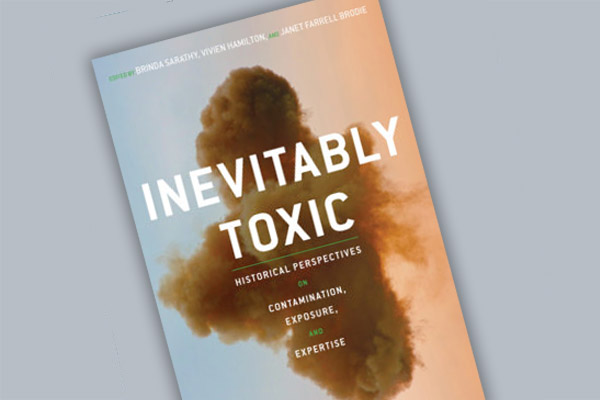“Illuminating Toxicity,” by Vivien Hamilton
November 20, 2019
Inevitably Toxic: Historical Perspectives on Contamination, Exposure, and Expertise is a collection of essays examining the exposure of humans to radiation, industrial waste and pesticides, often in spaces where these toxic agents are invisible or appear innocuous.
My colleagues Brinda Sarathy (Pitzer) and Janet Farrell Brodie (Claremont Graduate University) and I wrote the book in the hopes of engaging a wide audience, and we were especially pleased to learn that the Association of College and Research Libraries (ACRL) is including the book on its list of Outstanding Academic Titles for 2019. This is a list that reflects the best in scholarly titles (10% of some 6,000 works) reviewed annually in Choice, a publishing unit of the ACRL. In developing this list, the editors look for excellence in presentation and scholarship as well as value to undergraduate students. This award will encourage libraries to purchase our book, bringing these stories to new audiences.
I became interested in issues of toxic exposure through my research into x-ray safety in the early 20th century. The first doctors to use x-rays were remarkably determined to keep using and experimenting with this new technology despite the growing awareness that x-ray radiation caused burns, hair loss and cancers. So many of the early x-ray workers died from radiation injuries that there is a memorial in Hamburg dedicated to these x-ray martyrs. And yet, despite these dangers, it took 30 years for the American radiological community to produce a set of safety guidelines. As I started to think about hospital x-ray rooms as potentially toxic spaces, I realized that the pattern I was seeing wasn’t unique to hospitals. Over and over again, researchers, governments and industries have tended to minimize risk, preferring action over caution. The essays in this book show how ubiquitous various kinds of toxic spaces have become in our everyday lives, uncovering the processes that have led to their creation and asking who has been most harmed.
The question of relationships between experts and citizens is at the heart of a number of stories in our book. Often the people most impacted by toxicity are those with the least agency—in the United States, the impact of industrial pollution falls disproportionately on poorer communities of color, communities who have often been excluded from participating in science. Their lived experience is crucial to understanding the impact of toxicity. The challenge is not simply for scientific experts to find ways of explaining dangers and regulations to non-experts, but to find ways to develop partnerships so that scientists, engineers and citizens can collaborate to create solutions.
Our hope is that Inevitably Toxic will help point the way to a less toxic future by encouraging greater caution around the creation and regulation of toxic landscapes. The following excerpt is taken from the introduction to the book, written by me and Brinda Sarathy.
“A number of key questions motivate the book: To what extent do we know about the processes resulting in contaminated places, and do we, in fact, even recognize such spaces for what they are? How is it that toxic environments have become so pervasive while at the same time remaining invisible, overlooked, or ignored? Why do conditions of normalized toxicity fail to rouse mass outcry? Numerous scholars from a broad range of academic disciplines—from environmental history to public health, from sociology to geography, and from science and technology studies to environmental philosophy—have tackled such questions in their rich and diverse writings on toxic environments. However, this substantive and growing body of interdisciplinary scholarship tends to be written by and for the consumption of other academics. As professors of the liberal arts, we are also keenly aware that there is a broader audience to be engaged. In tackling the emergence of toxic environments in multiple sites across the twentieth century and into the twenty-first, we have therefore purposely written this book for a nonexpert audience. We have often found compelling storytelling to be the most effective means of capturing our students’ imaginations and sparking critical conversations. We hope that by conveying histories of toxicity in this intellectually rooted and evocative manner, a broader audience will be similarly engaged.
“The stories in this volume draw attention to a diverse set of toxic spaces in the United States, Canada, and Japan, spaces filled with x-rays, nuclear radiation, industrial waste, pesticides, and other chemical contaminants. Given the often-imperceptible nature of these agents, our first goal with this collection is simply one of illumination. Taken together, these chapters show us the ways in which exposure to toxicity has become routine, as toxic spaces have become increasingly interwoven into the economic structures and fabric of everyday life. Even more, these stories demonstrate that the burden of exposure continues to fall disproportionately on those already marginalized by class, race, and structures of colonization. Illuminating this reality, however, is just the first step. Our ultimate hope is that uncovering the histories of these spaces will make complacency impossible.
“Given the pervasive nature of toxic spaces and the urgent need for action, it might be surprising that most of the work in this book is historical rather than contemporary. Why examine x-ray rooms in the 1920s or pesticide use in the 1970s when we need to address water contamination from fracking right now? If we know the current state of contamination at various sites, why delve into archives to pull out debates and decisions that are over half a century old? We suggest that this kind of historical analysis is powerful precisely because it disrupts the sense that our current predicament is inevitable.
“Understanding how it is that these spaces came into being can help us identify contemporary institutions as well as modes of thinking and acting that continue to allow environments of toxicity to persist. This seems especially urgent given the current political climate of deregulation in the United States, in which calls to ‘grow the economy’ have become routine and are decoupled from any meaningful analysis of the ecologically unsustainable, socially exploitative, and violent processes through which capitalist relations operate. Careful historical analysis can illuminate these realities and inspire us to see how we can intervene to stem the tide of toxic spaces now and in the future.”
 Vivien Hamilton is associate professor of the history of science in the Department of Humanities, Social Sciences, and the Arts. She teaches a wide range of courses in the history of science, technology and medicine, asking questions about the cultural authority of science, the multiple occurrences of seemingly revolutionary shifts in scientific theory and practice in history, and the impact of structures of race, class and gender on the production of scientific knowledge. Her research focuses in particular on medical technologies, including x-rays, in the late 19th and early 20th centuries.
Vivien Hamilton is associate professor of the history of science in the Department of Humanities, Social Sciences, and the Arts. She teaches a wide range of courses in the history of science, technology and medicine, asking questions about the cultural authority of science, the multiple occurrences of seemingly revolutionary shifts in scientific theory and practice in history, and the impact of structures of race, class and gender on the production of scientific knowledge. Her research focuses in particular on medical technologies, including x-rays, in the late 19th and early 20th centuries.